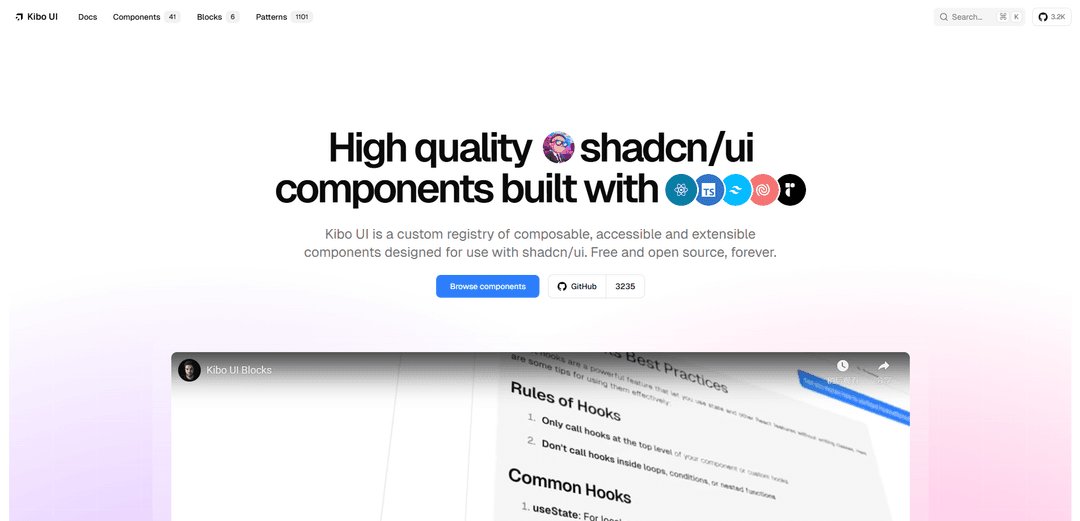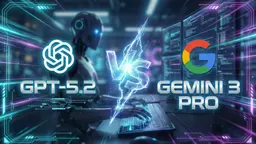
Kibo UI
Kibo UI es un registro personalizado de componentes de React composables, accesibles y de código abierto construidos sobre shadcn/ui que proporciona componentes de UI avanzados como gráficos de Gantt, tableros Kanban, lienzos colaborativos y primitivas de chat de IA para ayudar a los desarrolladores a construir interfaces más ricas más rápido.
https://www.kibo-ui.com/?ref=producthunt&utm_source=aipure

Información del Producto
Actualizado:09/11/2025
¿Qué es Kibo UI?
Kibo UI extiende la filosofía de shadcn/ui al proporcionar una biblioteca completa de componentes accesibles y listos para producción que manejan patrones de UI complejos. Mientras que shadcn/ui se centra en primitivas básicas de Radix UI, Kibo UI ofrece componentes más sofisticados con funcionalidad integrada como cargas de archivos de arrastrar y soltar, interfaces de búsqueda avanzadas y validación de formularios compleja. Construido con Next.js, TypeScript, Tailwind CSS y primitivas de Radix UI, sigue los mismos principios de composabilidad y el tema de variables CSS que hace que se integre perfectamente con los proyectos existentes de shadcn/ui.
Características Principales de Kibo UI
Kibo UI es un registro personalizado de componentes componibles, accesibles y de código abierto diseñados específicamente para su uso con shadcn/ui. Extiende las primitivas básicas de shadcn/ui con componentes más complejos a nivel de aplicación, como diagramas de Gantt, tableros Kanban, selectores de color y chatbots de IA. La biblioteca ofrece más de 40 componentes avanzados, 6 bloques preconstruidos y más de 1000 patrones que son totalmente personalizables, accesibles y se integran perfectamente con los proyectos shadcn/ui existentes mediante variables CSS.
Biblioteca de componentes avanzada: Proporciona componentes sofisticados más allá de las primitivas básicas, incluidos diagramas de Gantt, tableros Kanban, editores de texto enriquecido, selectores de color y lienzos colaborativos con funciones en tiempo real
Integración perfecta: Funciona perfectamente con los proyectos shadcn/ui existentes a través de variables CSS y se puede instalar rápidamente utilizando Kibo UI o shadcn CLI
Accesibilidad y capacidad de composición: Todos los componentes se construyen teniendo en cuenta la accesibilidad (cumplen con WCAG) y son totalmente componibles, lo que permite a los desarrolladores personalizarlos y ampliarlos para necesidades específicas
Bloques y patrones preconstruidos: Incluye bloques listos para usar como chatbots de IA, formularios y páginas de precios, además de más de 1000 patrones para acelerar el desarrollo
Casos de Uso de Kibo UI
Desarrollo de paneles de control empresariales: Cree interfaces administrativas complejas con tablas de datos, diagramas de Gantt y tableros Kanban para la gestión de proyectos y la colaboración en equipo
Aplicaciones impulsadas por IA: Implemente funciones de IA utilizando interfaces de chatbot preconstruidas y componentes de entrada avanzados diseñados para interacciones de IA
Creación de sistemas de diseño: Cree sistemas de diseño integrales con componentes consistentes, accesibles y personalizables que funcionen en diferentes proyectos
Herramientas colaborativas: Desarrolle funciones colaborativas en tiempo real utilizando componentes como lienzo colaborativo y capacidades de edición multiusuario
Ventajas
Extiende shadcn/ui con componentes complejos listos para producción
Código abierto y de uso gratuito para siempre
Fuerte enfoque en la accesibilidad y la personalización
Configuración rápida e integración perfecta con proyectos existentes
Desventajas
Requiere la configuración existente de shadcn/ui con variables CSS
Algunos componentes podrían considerarse relativamente nuevos/experimentales
Las dependencias de múltiples tecnologías podrían aumentar el tamaño del paquete
Cómo Usar Kibo UI
Instalar requisitos previos: Asegúrese de tener shadcn/ui y Tailwind CSS instalados en su proyecto. Su configuración de shadcn/ui debe usar la versión de variables CSS (esta es la predeterminada).
Instalar Kibo UI: Instale los componentes de Kibo UI usando la CLI de kibo-ui o la CLI de shadcn. Ejecute: 'npx kibo-ui@latest add <nombre-del-componente>' (p. ej. 'npx kibo-ui@latest add gantt')
Importar componentes: Importe los componentes de Kibo UI deseados desde su directorio de componentes. Por ejemplo: 'import { Announcement, AnnouncementTag, AnnouncementTitle } from '@/components/ui/kibo-ui/announcement''
Usar componentes: Use los componentes importados en su código JSX/TSX. Los componentes se pueden componer y personalizar usando props y clases de Tailwind CSS.
Estilizar componentes: Personalice los componentes usando las variables CSS de shadcn/ui y las utilidades de Tailwind CSS. Los componentes usan el mismo sistema de temas que shadcn/ui.
Extender componentes: Los componentes se pueden extender con funcionalidad adicional, ya que aceptan atributos HTML primitivos. Por ejemplo, AnnouncementTag extiende HTMLAttributes<HTMLDivElement>.
Combinar con shadcn/ui: Mezcle y combine componentes de Kibo UI con componentes centrales de shadcn/ui para crear interfaces de usuario ricas y dinámicas.
Añadir más componentes: Instale componentes adicionales según sea necesario usando la CLI. Los componentes se añaden bajo demanda para mantener su aplicación ligera y solo incluir código para las funciones que esté utilizando.
Preguntas Frecuentes de Kibo UI
Kibo UI es un registro personalizado de componentes componibles, accesibles y extensibles diseñados para su uso con shadcn/ui. Es gratuito y de código abierto, y proporciona componentes complejos adicionales que van más allá de las primitivas básicas de shadcn/ui.
Artículos Populares

Tendencia de fotos navideñas con IA 2025: Prompts virales, generadores gratuitos y cómo crear impresionantes fotos navideñas con IA
Dec 23, 2025

ChatGPT Image 1.5 vs Nano Banana Pro: La batalla por el mejor generador de imágenes con IA en 2025
Dec 18, 2025

ChatGPT Image 1.5 Ya Está Aquí: Dentro del Nuevo Modelo de Generación de Imágenes con IA de OpenAI en 2025
Dec 18, 2025

OpenAI GPT-5.2 vs Google Gemini 3 Pro: Última Revisión 2025
Dec 18, 2025







